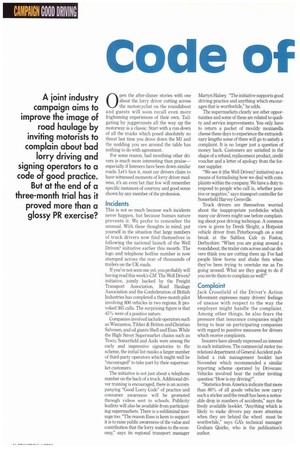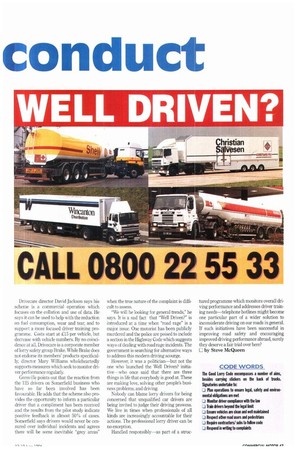Code of conduct
Page 60

Page 61

If you've noticed an error in this article please click here to report it so we can fix it.
A joint industry campaign aims to improve the image of road haulage by inviting motorists to complain about bad lorry driving and signing operators to a code of good practice. But at the end of a three-month trial has it proved more than a glossy PR exercise?
0 pen the after-dinner stories with one about the lorry driver cutting across the motorcyclist on the roundabout and guests will soon recall even more frightening experiences of their own. Tailgating by juggernauts all the way up the motorway is a classic. Start with a run-down of all the trucks which posed absolutely no threat last time you drove down the Ml and the nodding you see around the table has nothing to do with agreement.
For some reason, bad mouthing other drivers is much more interesting than praise— especially if listeners have been down similar roads. Let's face it, most car drivers claim to have witnessed moments of lorry driver madness, it's an even bet that few will remember specific instances of courtesy and good sense shown by any member of the profession.
Incidents
This is not so much because such incidents never happen, but because human nature prevents it. We prefer to remember the unusual. With these thoughts in mind, put yourself in the situation that large numbers of truck drivers now find themselves in following the national launch of the Well Driven? initiative earlier this month. The logo and telephone hotline number is now stamped across the rear of thousands of trailers on the UK roads.
If you've not seen one yet, you probably will having read this week's CM The Well Driven? initiative, jointly backed by the Freight Transport Association, Road Haulage Association and the Confederation of British Industries has completed a three-month pilot involving 800 vehicles in two regions. It provoked 365 calls. The surprising figure is that 45% were of a positive nature.
Companies involved include operators such as Wincanton, Tibbet & Britten and Christian Salvesen, and oil giants Shell and Esso. While the High Street Supermarket chains such as Tesco, Somerfield and Asda were among the early and impressive signatories to the scheme, the initial list masks a larger number of third-party operators which might well be "encouraged" to take part by their supermarket customers.
The initiative is not just about a telephone number on the back of a truck. Additional driver training is encouraged, there is an accompanying "Good Lorry Code" of practice and consumer awareness will be promoted through videos sent to schools. Publicity leaflets will also be available from participating supermarkets. There is a subliminal message too. "The reason Esso is keen to support it is to raise public awareness of the value and contribution that the lorry makes to the economy," says its regional transport manager Martyn Halsey. "The initiative supports good driving practice and anything which encourages that is worthwhile," he adds.
The supermarkets clearly see other opportunities and some of these are related to quality and service improvements. You only have to return a packet of mouldy mozzarella cheese these days to experience the extraordinary lengths some of them will go to satisfy a complaint. It is no longer just a question of money back. Customers are satisfied in the shape of a refund, replacement product, credit voucher and a letter of apology from the former supplier.
"We see it (the Well Driven? initiative) as a means of formalising how we deal with complaints within the company. We have a duty to respond to people who call in, whether positive or negative," says transport controller for Somerfield Harvey Grenville.
Truck drivers are themselves worried about the inappropriate yardsticks which many car drivers might use before complaining about poor driving technique. A common view is given by Derek Sleight, a Hotpoint vehicle driver from Peterborough on a rest break at the Saltbox Cafe in Foston, Derbyshire: "When you are going around a roundabout, the trailer cuts across and car drivers think you are cutting them up. I've had people blow horns and shake fists when they've been trying to overtake me as I'm going around. What are they going to do if you invite them to complain as well?"
Complaint
Jack Crossfield of the Driver's Action Movement expresses many drivers' feelings of unease with respect to the way the employer might handle the complaint. Among other things, he also fears the pressure that insurance companies might bring to bear on participating companies with regard to punitive measures for drivers which receive complaints.
Insurers have already expressed an interest in such initiatives. The commercial motor (no relation) department of General Accident published a risk management booklet last November which recommended a similar reporting scheme operated by Drivecare. Vehicles involved bear the rather inviting question "How is my driving?".
"Statistics from America indicate that more than 80% of all goods vehicles now carry such a sticker and the result has been a noticeable drop in numbers of accidents," says the freely available booklet. "Anything which is likely to make drivers pay more attention when they are behind the wheel must be worthwhile," says GA's technical manager Graham Quirke, who is the publication's author. Drivecare director David Jackson says his scheme is a commercial operation which focuses on the collation and use of data. He says it can be used to help with the reduction on fuel consumption, wear and tear, and to support a more focused driver training programme. Costs start at £15 per vehicle, but decrease with vehicle numbers. By no coincidence at all, Drivecare is a corporate member of lorry safety group Brake, While Brake does not endorse its members' products specifically, director Mary Williams wholeheartedly supports measures which seek to monitor driver performance regularly.
Grenville points out that the reaction from the 125 drivers on Somerfield business who have so far been involved has been favourable. He adds that the scheme also provides the opportunity to inform a particular driver that a compliment has been received and the results from the pilot study indicate positive feedback in almost 50% of cases. Somerfield says drivers would never be censured over individual incidents and agrees there will be some inevitable "grey areas" when the true nature of the complaint is difficult to assess.
"We will be looking for general trends," he says. It is a sad fact that "Well Driven?" is introduced at a time when "road rage" is a major issue. One motorist has been publicly murdered and the police are poised to include a section in the Highway Code which suggests ways of dealing with road rage incidents. The government is searching for alternative ways to address this modern driving scourge.
However, it was a politician—but not the one who launched the Well Driven? initiative—who once said that there are three things in life that everybody is good at. These are making love, solving other people's business problems, and driving.
Nobody can blame lorry drivers for being concerned that unqualified car drivers are being invited to judge their driving prowess. We live in times when professionals of all kinds are increasingly accountable for their actions. The professional lorry driver can be no exception.
Handled responsibly—as part of a struc
tured programme which monitors overall driving performance and addresses driver training needs—telephone hotlines might become one particular part of a wider solution to inconsiderate driving on our roads in general. If such initiatives have been successful in improving road safety and encouraging improved driving performance abroad, surely they deserve a fair trial over here?
E by Steve McQueen CODE WORDS
The Good Lorry Code encompasses a number of aims, besides carrying stickers on the back of trucks.
Sigmatoties undertake to:
_J Plan operations to ensure legal, safety and environ
mental obligations are met
_J Monitor driver compliance with the law 1_1 Train drivers beyond the legal limit
Ensure vehicles are clean and well maintained
Ui Respect other road users and pedestrians L.] Require contractors/ subs to follow code CA Respond in writing to complaints






























































































































